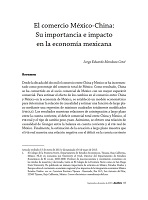El comercio México-China: Su importancia e impacto en la economía mexicana
DOI:
https://doi.org/10.32870/mycp.v4i12.492Palabras clave:
Cuenta corriente, déficit comercial, tipo de cambio, exportaciones de China, manufacturas, PIBResumen
Desde la década del dos mil el comercio entre China y México se ha incremen-tado como porcentaje del comercio total de México. Como resultado, Chinase ha convertido en el socio comercial de México con un mayor superávitcomercial. Para estimar el efecto de los cambios en el comercio entre Chinay México en la economía de México, se estableció un modelo econométricopara determinar la relación de causalidad y estimar una función de largo pla-zo mediante una regresión de mínimos cuadrados totalmente modificados(FMOLS). Los resultados muestran relaciones de cointegración a largo plazoentre la cuenta corriente, el déficit comercial total entre China y México, elPIB real y el tipo de cambio peso-yuan. Asimismo, se obtuvo una relación decausalidad de Granger entre la balanza en cuenta corriente y el pibreal de México. Finalmente, la estimación de la ecuación a largo plazo muestra que el PIB real muestra una relación negativa con el déficit en la cuenta corriente y una relación positiva con los movimientos del tipo de cambio entre el peso y el yuan.Descargas
Citas
Asteriou, Dimitrios y Stephen Hall (2006), Applied Econometrics, a Modern Approach, New York, Palgrave Macmillan.
Blecker, Robert (2006), “Macroeconomic and Structural Constraints on Export-Led Growth in Mexico”, Working Paper Series, núm. 2006-05, American University, Department of Economics.
Edwards, Sebastian (2002), “Does the Current Account Matter?”, en Sebastian Edwards y Jeffrey A. Frankel (ed.), Preventing Currency Crises in Emerging Markets, United States of America, University of Chicago Press, pp. 21-76.
Edwards, Sebastian (2005), “Is U.S. Current Account Deficit Sustainable? And if Not, How costly is Adjustment Likely to be?”, NBER Working Paper, núm. 1154. Disponible en: http://www.nber.org/papers/w11541. Consultado: noviembre 14 de 2014.
Feenstra, Robert y Shang Jin Wei (2010), China’s Growing Role in World Trade, United States of America, University of Chicago Press.
Feenstra, Robert C.; Hai Wen; Woo T., Wing y Yao Shunli (1998), “The USChina Bilateral Trade Balance: Its Size and Determinants”, nber Working Paper, núm. 6598, National Bureau of Economic Research.
Fischer, Stanley (1988), “Real Balances, The Exchange Rate, and Indexation: Real Variables in Disinflation”, Quarterly Journal of Economics, 103(1), pp. 27-49.
Gallagher, Kevin y Roberto Porzecansk (2008), “China Matters: China’s Economic Impact in Latin America”, Latin American Research Review, 43(1), pp. 185-200.
Gould, David y Roy Ruffin (1996), “Trade Deficits: Causes and Consequences”, Federal Reserve Bank of Dallas, Economic Review, fourth quarter. Septiembre-diciembre de 2015. Análisis 91 El comercio México-China: Su importancia e impacto en la economía mexicana
Grubel, Herbert G. y P. J. Lloyd (1971), “The Empirical Measurement of Intraindustry Trade”, The Economic Record, 47, pp. 494 - 517
Hanson, Gordon (2010), “Why isn’t Mexico Rich?”, Journal of Economic Literature, 48(4), pp. 987-1004.
Hernández Clemente Cervantes, Miguel; Mauricio Montoya y Raúl Montalvo (2011), Anuario estadístico de China. Un panorama economic, México, itesm.
Hernández, Roberto (2012), “Economic Liberalization and Trade Relations between Mexico and China”, Journal of Current Chinese Affairs, 41(1), pp. 49-96.
Higgins, Matthew y Thomas Klitgaard (1998), “Viewing the Current Account Deficit as a Capital Inflow”, Current Issues in Economics and Finance, Federal Reserve New York, 4(13), pp. 1-6.
Johansen, Soren (1991), “Estimation and Hypothesis testing of Cointegration Vectors in Gausian Vector Autorregresive Models”, Econometrica, 59(6), pp. 1551-1580.
Johnston, Jack y Dinardo, John (1997), Econometric Methods, 4a ed., United States of America, McGraw-Hill.
Kehoe, Timothy J. y Kim J Ruhl (2010), “Why have Economic Reforms in Mexico not generated Growth?”, NBER Working Paper Series, núm. 16580, National Bureau of Economic Research.
Kwiatkowski Denis, Phillips; C. B., Peter; Schmidt, Peter y Shin Yongcheol (1992), “Testing the Null Hypothesis of Stationarity against the Alter- native of a Unit Root: How sure are we that Economic Time Series have a Unit Root?”, Journal of Econometrics, 54(1-3), pp. 159-178.
Mendoza, Eduardo (2013), “El efecto de las exportaciones chinas hacia Estados Unidos en la demanda de empleo del sector manufacturero en México 2004-2012”, Portes, Revista Mexicana de Estudios sobre la Cuenca del Pacífico, 7(14), pp. 33-69.
Moreno-Brid, Juan Carlos (1998), “México: crecimiento económico y restricción de la balanza de pagos”, Comercio Exterior, 48 (6), pp. 478-486.
Obstfeld, Maurice (2012), “Does the Current Account Still Matter?”, American Economic Review, Papers & Proceedings, 102(3), pp. 1–23.
Pesaran Hashem y Yongcheol Shin (1998), “Generalized Impulse Response Analysis in Linear Multivariate Models”, Economics Letters, 58(1), pp. 17-29.
Phillips P.C. y B. E. Hansen (1990), “Statistical Inference in Instrumental Variable Regressions with I(1) Process”, Review of Economic Studies, 57, pp. 99-125.

Publicado
Cómo citar
Número
Sección
Licencia
Política de acceso abierto
Esta revista proporciona un acceso abierto a su contenido, fiel al principio de que ofrecer al público un acceso libre a las investigaciones ayuda a un mayor intercambio global del conocimiento.
MyCP se publica bajo la licencia de Creative Commons Reconocimiento-No Comercial CC BY-NC
Los contenidos serán publicados en versión PDF y XML.
Los autores(as) que publiquen en México y la Cuenca del Pacífico aceptan las siguientes condiciones:
De acuerdo con la legislación de derechos de autor, México y la Cuenca del Pacífico reconoce y respeta el derecho moral de los autores(as), así como la titularidad del derecho patrimonial, mismo que será cedido a la Universidad de Guadalajara para su difusión en acceso abierto.
México y la Cuenca del Pacífico no realiza cargos a los autores(as) por enviar y procesar artículos para su publicación.
Los autores(as) pueden realizar otros acuerdos contractuales independientes y adicionales para la distribución no exclusiva de la versión del artículo publicado en México y la Cuenca del Pacífico (por ejemplo, incluirlo en un repositorio institucional o darlo a conocer en otros medios en papel o electrónicos) siempre que indique clara y explícitamente que el trabajo se publicó por primera vez en México y la Cuenca del Pacífico.
Una vez que se acepte el artículo para su publicación los autores(as) deben remitir el formato de carta-cesión de derechos de la publicación debidamente requisitado y firmado por los autores(as). Este formato debe ser remitido en archivo PDF paralelamente con la versión final del artículo al correo: mexicoylacuenca@gmail.com.
Los lectores/usuarios de México y la Cuenca del Pacífico pueden acceder directamente al contenido de manera libre y gratuita en todo momento, incluyendo cuando un nuevo número es colocado en la plataforma. Se permite al lector/usuario citar, compartir (electrónicamente y de manera física), imprimir y distribuir el material siempre que se indique de manera clara y explícitamente que el trabajo se publicó por primera vez en México y la Cuenca del Pacífico. Es necesario citar de manera correcta el trabajo y no debe de ser utilizado con fines comerciales.




